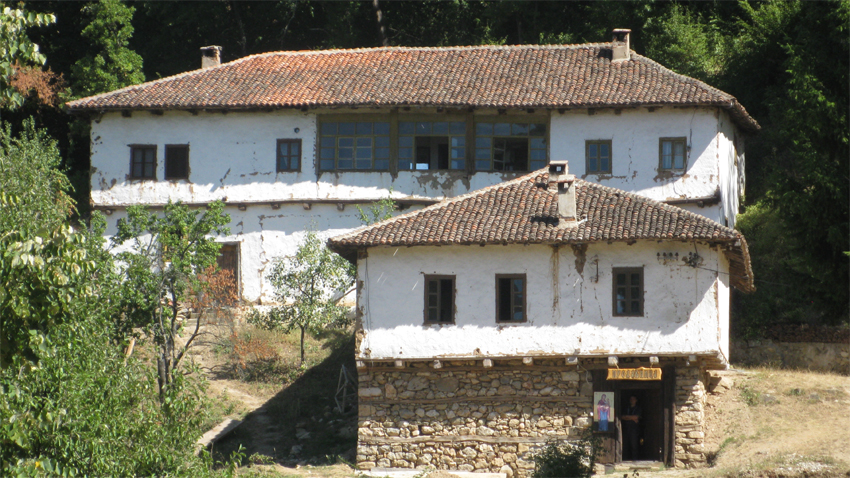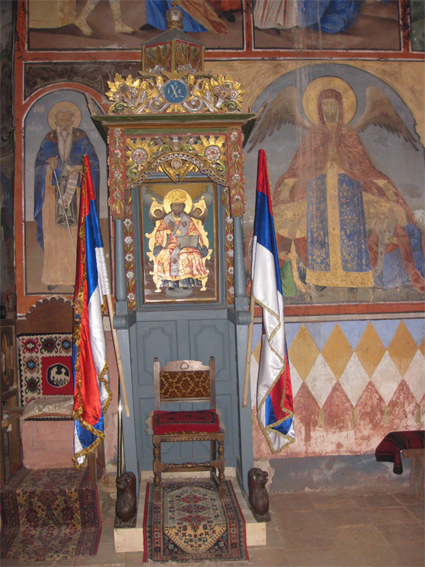There is a fabulous river that springs in today’s lands of Serbia and then heads to Bulgaria. It curves, bringing divine beauty here and then gets back to the neighboring territory, where it flows into the Nishava River. We are talking about Erma. The Sukovo Monastery can be found there, on the right bank of the river in Serbia and 18 km away from the town of Pirot, far away from the main road and amidst beautiful nature. It is devoted to the Ascension of the Holy Virgin and is an oasis for those, who seek their inner peace. Tour guide Zhivka Mantarkova, a senior curator at the museum of the Rila Monastery gives us interesting facts on the holy spot.
 “No exact recorded data testifies on the monastery’s establishment. However, we are well aware that this is an old Bulgarian sanctuary from the Western Out-lands on the territory of present day Serbia, the Eparchy of Nis. Historians believe that the first monastery at the spot was built in the early Christian époque, somewhere around the 4th century. A 1019 document mentions it in the diocese of the Sredets Eparchy, a Bulgarian one and under the jurisdiction of the Ohrid Archdiocese. The same document testifies on the several demolitions of the monastery during the Ottoman Rule. Local Bulgarian people built it up again in the 17th century. The monastery was decorated with frescoes in 1606.”
“No exact recorded data testifies on the monastery’s establishment. However, we are well aware that this is an old Bulgarian sanctuary from the Western Out-lands on the territory of present day Serbia, the Eparchy of Nis. Historians believe that the first monastery at the spot was built in the early Christian époque, somewhere around the 4th century. A 1019 document mentions it in the diocese of the Sredets Eparchy, a Bulgarian one and under the jurisdiction of the Ohrid Archdiocese. The same document testifies on the several demolitions of the monastery during the Ottoman Rule. Local Bulgarian people built it up again in the 17th century. The monastery was decorated with frescoes in 1606.”
The place is full of legends and mystics, related to the magnificent land around. For instance, there is a legend on a divine sign.
“The latest history of the temple tells the names of little shepherd Velio, who became a monk later on under the name of Veniamin, and priest Yovan,” Mrs. Mantarkova goes on to say. “They settled into a place, called Tsarkvishteto. Mother Mary appeared in the dreams of Velio and told him to build a monastery. They both started to dig and found an icon and a night-light, which testified clearly on the earlier existence of a temple there. However, a Turk from Pirot, Sali Bay owned the spot. His son Emin decided to desecrate the holy place, but he got paralyzed and lost his memory at the same time. Desperate, his father asked father Yovan to say a prayer for the boy. Emin was healed afterwards and the thankful Sali Bay worked for a special sultan epistle for the restoration of the monastery at this spot precisely. The document was issued in 1856 in Constantinople.”
 The Sukovo Monastery, the way we know it today, was built in the course of two years – 1857–1859, as the style is typically Bulgarian, with grey stone and lime. The year 1859 is engraved over the main entrance of the temple, while a table inside reads the name of the builders – Milcho and Goga. The frescoes were finished in 1871. “In the words of former Primate of the monastery Archpriest Lyubodrag four schools painted the icons – the ones of Serbs, Bulgarians, Greeks and Russians. However, I have seen a written testimony of the Samokov School,” Zhivka Mantarkova says. “The murals are related to the names of Sotir Valyov in the period 1875 – 76 and Vassil Pophristov, who painted in the narthex between 1869 and 1871. A fresco of Mother Mary Krilatitsa can be seen inside the church, typical for the Samokov School. This is a version of the Intercession of the Theotokos, but Mother Mary has spread wings here over people’s heads, instead of a roof. The icon of the great Bulgarian martyr St. John of Rila can be found at a special spot, as well as the preserved head of monk Veniamin that we mentioned above.”
The Sukovo Monastery, the way we know it today, was built in the course of two years – 1857–1859, as the style is typically Bulgarian, with grey stone and lime. The year 1859 is engraved over the main entrance of the temple, while a table inside reads the name of the builders – Milcho and Goga. The frescoes were finished in 1871. “In the words of former Primate of the monastery Archpriest Lyubodrag four schools painted the icons – the ones of Serbs, Bulgarians, Greeks and Russians. However, I have seen a written testimony of the Samokov School,” Zhivka Mantarkova says. “The murals are related to the names of Sotir Valyov in the period 1875 – 76 and Vassil Pophristov, who painted in the narthex between 1869 and 1871. A fresco of Mother Mary Krilatitsa can be seen inside the church, typical for the Samokov School. This is a version of the Intercession of the Theotokos, but Mother Mary has spread wings here over people’s heads, instead of a roof. The icon of the great Bulgarian martyr St. John of Rila can be found at a special spot, as well as the preserved head of monk Veniamin that we mentioned above.”
Russian monks from Athos visited the Sukovo Monastery in 1925. Those built a chapel to the north of the church. The dining room and the new wing of the monastery were finished in 2003.
“Monks have lived in the Sukovo Monastery again for several years. The already mentioned Archpriest Lyubodrag, who has been transferred to another temple, has done quite a lot for the place, including the newly built bridge over Erma, leading to it. The monks continue his work and now the old and unstable narthex is demolished and a new one is being constructed. There is a magnificent church store that sells not only icons and literature, but also monastery brandy, wine and walnut liqueur, produced by the monks and quite tasty, actually. Of course, masses are served there every day too…”
English version: Zhivko Stanchev
Photos: Miglena Ivanova
After Cheesefare (Forgiveness) Sunday, the Great Lent has begun on March 3. Orthodox Christians will abstain from eating animal food including meat, eggs, milk and dairy products. The Great Lent symbolizes the 40 days which Jesus spent in the..
Batak is a name every Bulgarian remembers with deference and pain because the fate of the small town in the Rhodopes is scarred by one of the bloodiest events in national memory – the Batak massacre. During the first days after the outbreak of..
There is a map which helped usher in the birth of modern Bulgaria during the Russo-Turkish War of 1877-1878. The Austro-Hungarian researcher Felix Kanitz (1829 – 1904) was the first West European to have travelled to more than 3,200 towns and villages..

+359 2 9336 661
